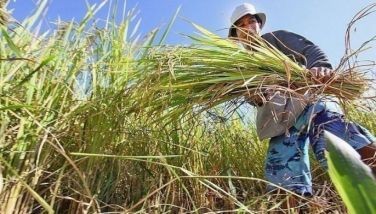DAR promotes rice ratooning technology
December 15, 2002 | 12:00am
The Department of Agrarian Reform (DAR) is undertaking an expansion of its rolodge ratooning project in six rice fields nationwide to maximize the production of palay at lesser cost.
The project dubbed "Rolodge Advance Rice Ratooning", is now being implemented in as big as 1,000-hectare adjoining farms from pocket-sized rice fields in Bulacan and Camarines Sur in Luzon; Bohol and Leyte in Visayas; and Bukidnon and Zamboanga del Sur in Mindanao.
According to DAR Secretary Hernani Braganza, applying the technology in continuos farms would minimize losses arising from possible infestation since such scheme could prevent concentration of pests in one small area alone.
"The project starts on land preparation for the next year’s first cropping, which normally begins this month because the success of the ratoon crop is best assured with proper pre-ratoon crop (or) mother crop management," Braganza said.
The DAR noted that the technology could enable farmers to gain extra harvest of at least 60 sacks of palay.
The average harvest, the department said, is half the normal harvest per cropping season. This may even increase to the level of production of the mother crop once the technology is perfected.
The DAR, likewise, pointed out that the rolodge ratooning lessens production cost by some 65 percent from P23,000 per hectare to as low as P8,000.
It even makes the crop ready for harvest in 75 days, which is about a month less than the mother crop.
The rolodge ratooning was invented by agricultural scientist Alfredo Calendacion Sr., who is currently working as a consultant to the DAR.
Calendacion said ratooning is a natural phenomenon in grass family (graminae) that when cut and exposed to appropriate environment, it will develop new sprouts, with characteristic equal to its original form and capacities.
He said that with the technology farmers can minimize rice production without going through the whole process of plowing the rice fields, preparing the seeds and transplanting the seedlings that adds to cost of production. The scientist explained that "all the farmers have to do is flatten the rice stalks, those left after harvest, to the saturated ground and wait until new tillers sprout" that occurs about five to eight days usually.
Nitrogen fertilizers and pesticides could be applied later on whenever the need arises, he added.
The DAR pursued the project after the technology showed favorable results following a year of experiment in the pocket-sized farms.
"The promotion of the technology suggest that DAR is not only involved in land distribution, but is also very much active in making these lands productive and in helping farmer-beneficiaries attain financial stability," Braganza said.
The project dubbed "Rolodge Advance Rice Ratooning", is now being implemented in as big as 1,000-hectare adjoining farms from pocket-sized rice fields in Bulacan and Camarines Sur in Luzon; Bohol and Leyte in Visayas; and Bukidnon and Zamboanga del Sur in Mindanao.
According to DAR Secretary Hernani Braganza, applying the technology in continuos farms would minimize losses arising from possible infestation since such scheme could prevent concentration of pests in one small area alone.
"The project starts on land preparation for the next year’s first cropping, which normally begins this month because the success of the ratoon crop is best assured with proper pre-ratoon crop (or) mother crop management," Braganza said.
The DAR noted that the technology could enable farmers to gain extra harvest of at least 60 sacks of palay.
The average harvest, the department said, is half the normal harvest per cropping season. This may even increase to the level of production of the mother crop once the technology is perfected.
The DAR, likewise, pointed out that the rolodge ratooning lessens production cost by some 65 percent from P23,000 per hectare to as low as P8,000.
It even makes the crop ready for harvest in 75 days, which is about a month less than the mother crop.
The rolodge ratooning was invented by agricultural scientist Alfredo Calendacion Sr., who is currently working as a consultant to the DAR.
Calendacion said ratooning is a natural phenomenon in grass family (graminae) that when cut and exposed to appropriate environment, it will develop new sprouts, with characteristic equal to its original form and capacities.
He said that with the technology farmers can minimize rice production without going through the whole process of plowing the rice fields, preparing the seeds and transplanting the seedlings that adds to cost of production. The scientist explained that "all the farmers have to do is flatten the rice stalks, those left after harvest, to the saturated ground and wait until new tillers sprout" that occurs about five to eight days usually.
Nitrogen fertilizers and pesticides could be applied later on whenever the need arises, he added.
The DAR pursued the project after the technology showed favorable results following a year of experiment in the pocket-sized farms.
"The promotion of the technology suggest that DAR is not only involved in land distribution, but is also very much active in making these lands productive and in helping farmer-beneficiaries attain financial stability," Braganza said.
BrandSpace Articles
<
>
- Latest
Latest
Latest
November 9, 2024 - 3:43pm
By E.H. Edejer | November 9, 2024 - 3:43pm
June 9, 2024 - 5:55pm
By Alberto Peña | June 9, 2024 - 5:55pm
May 24, 2024 - 10:00am
May 24, 2024 - 10:00am
May 14, 2024 - 3:43pm
By Ian Laqui | May 14, 2024 - 3:43pm
April 10, 2024 - 5:12pm
By Ian Laqui | April 10, 2024 - 5:12pm
Recommended



























